A little off topic, but I mentioned this a while back on another post and there was some interest. Now it is finished! Or at least operational!
Feeling a little dejected about aircraft for various reasons, I have recently been building an Alleweder which my son described as ‘a jet aeroplane without the wings’. He was more perceptive than he realises because the original was designed by Bart Verhees who trained as an aerospace engineer and is also responsible for the Verhees Delta . He built the original Alleweder as a student project in the late 1980s and won a competition for a practical commuter vehicle. There have been a number of further versions of it, of which this is likely to be the last in Aluminium. 16kg carbon fibre wonders probably rendered it obsolete before it was completed, but I love it and I don’t care.
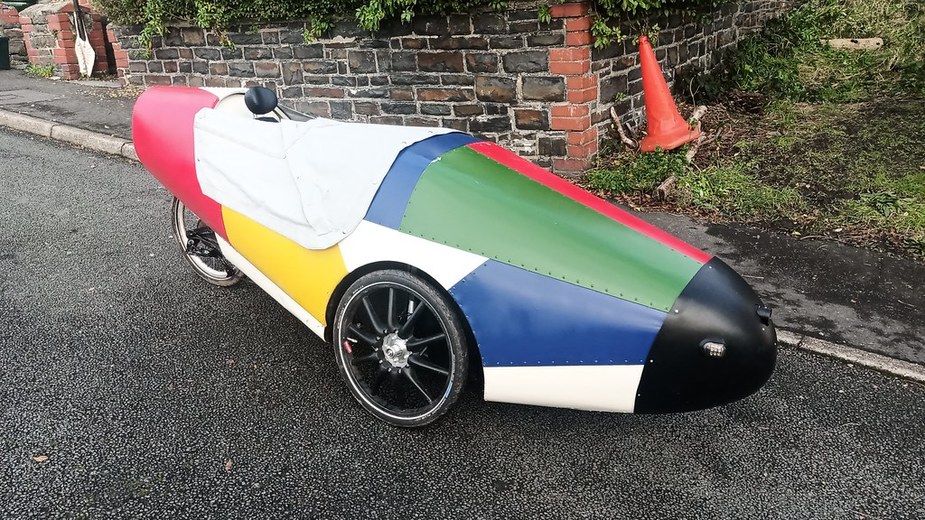
I haven’t weighed it, but I expect it to come in closer to 40kg than 30. The bell alone weighs 275g. My brother’s racing bike probably weighs a fifth as much as this creature. So why would any cyclist in his right mind want such a thing? As we all know, air resistance increases with the cube of speed. On a ‘normal’ bicycle, at 20mph a ballpark 90% of your energy is expended on air resistance and only 10% on drivechain losses and rolling resistance. Weight is less important than you might think. A 65kg cyclist and a 10kg bike together weigh 75kg. A 65kg cyclist and a 35kg velomobile together weigh 100kg. Up a really steep hill the velomobile will be 25% slower for the same power output* but on the flat, downhill and even whilst ascending shallow inclines, the velomobilist will be reaping the dividends of improved aerodynamics.
Construction was very well thought out. Beautiful CNC bulkheads have replaced the aviation style formed aluminium of previous versions. They make a reasonably foolproof rigid spine which holds the drivetrain and seat in position with little possibility for alignment errors. The metal panels are formed around this spine and some associated bulkheads. This is the part that required a degree of artistry and caution – it would be very easy to end up with the shell out of alignment or to drill holes in the wrong places. Some holes were pre-cut but I think a bit more RV-style matched hole technology would have transformed this aspect of building the kit and made it more foolproof.
It’s a truism in aviation that when something is 95% finished, there is still 95% still to go and that every ’mod takes at least 100 hours. Despite having done a fair amount of electronics, it took a surprising amount of time to wire the lights and indicators:
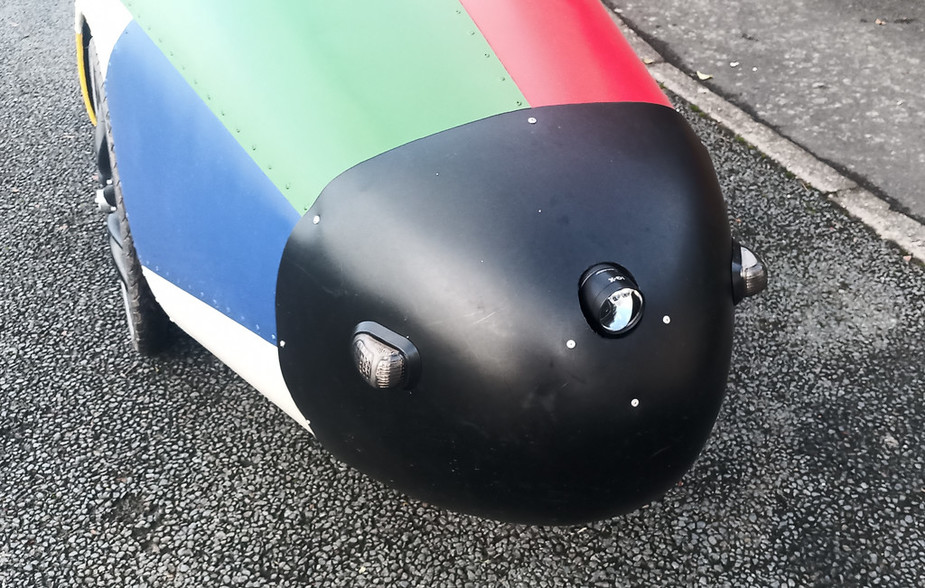
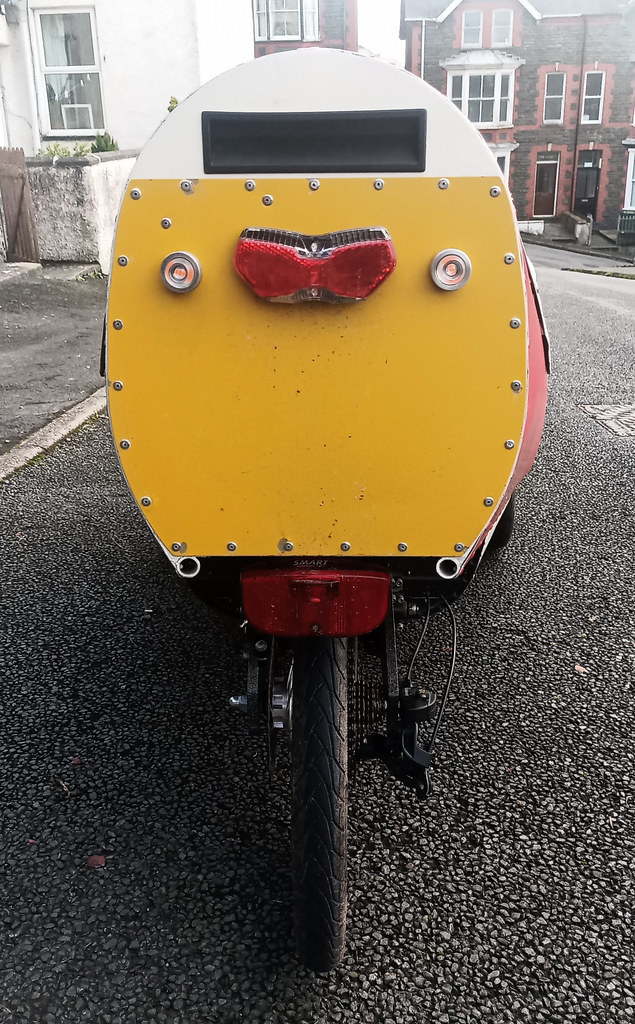
it was surprisingly hard to find good, lightweight solutions for the connectors. In the end I machined blocks of nylon and used crimp terminals:

Everything is managed by this control box here:

Not the most elegant, but it does the job and is meant to be waterproof (there are also some drain holes on the bottom). It has a voltmeter and an USB charging socket. The indicator lights and horn are controlled by some buttons on the steering column. The yellow button is for hazard warning lights.
But my favourite ‘custom’ bit is the lockable luggage compartment:

I had to put a fair amount of thought into making it sturdy enough to withstand sliding luggage and most importantly, not rattle!
The locking mechanism is based around a cam machined out of nylon:
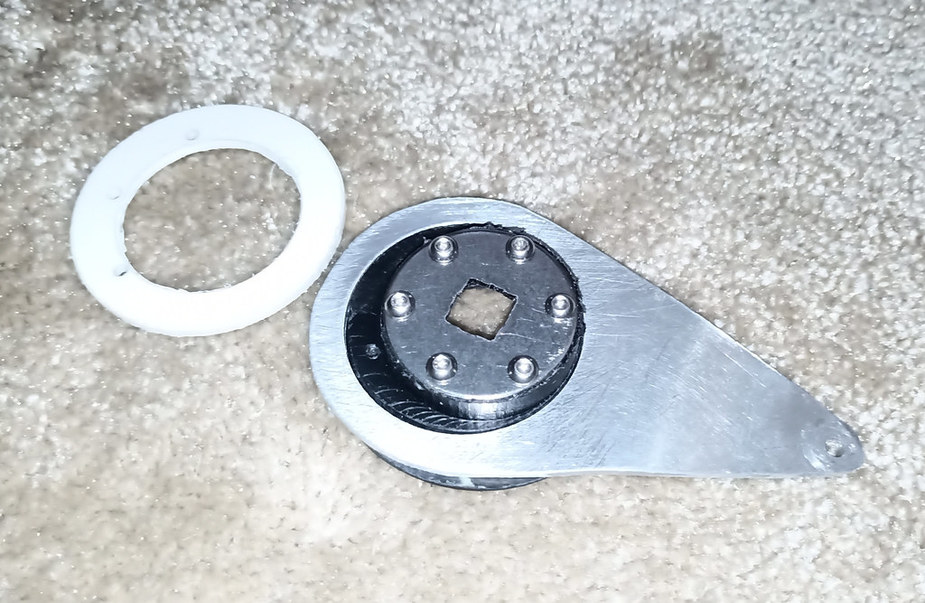

If I made it again, I would have been a bit more ambitious with the fit – there are only about 5mm between the bulkheads and the hatch, but it looks more. I had actually planned to put flanges either side of the hatch to hide the gap, and the bolts, but in the end it works fine and I couldn’t be bothered. I wouldn’t leave anything terribly valuable in it, but it is transformative to be able to park outside a shop then go in without bothering to take the pack containing your bicycle pump, repair kit and tools with you, as well as your helmet and cycling shoes. I can carry a big bag of shopping in the trunk, and two more big bags either side of the seat.
And of course the colour scheme. I woke up one morning knowing what colour it should be. Were’t not for that, it would have been completed long ago!
What is left to do? I am contemplating fitting a brushless motor to the back wheel as a dynamo so that I can ride for long distances without needing to find a campsite with an electrical socket. But I will be lucky to get enough time to do such a ride in the foreseeable future so there is no hurry.
I’ve only been riding it for a few weeks, but I really enjoy it. The handling is generally good. It can be a bit squirrelly as you approach 50mph but it is fine at regular speeds. I have done a fair bit of testing to see whether I could roll it, and it is harder than I expected (still quite do-able, I’m sure – I have a roll bar which has been unexpectedly tricky to fit, and given that I have no harness I’m not sure how useful it would be). As it is Dutch in origin, I had to adjust the gearing for local hills. It is not that much faster than a regular racing bike, but it is much more comfortable, particularly in driving rain and gales. Actually it probably is faster in a gale as well – you really find that headwinds are more tolerable than on a regular bike. And it is fine over sleeping policemen, which would probably destroy some of the 16kg carbon wonders. It’s early days, but I suspect that barring major mishaps my Alleweder will be more trouble-free than many other velomobiles, and hopefully with minimal maintenance.
This rather fun video gives a flavour of what building one involves:
but they have recently been discontinued so if you want one, you will have to make do with something like this instead!:
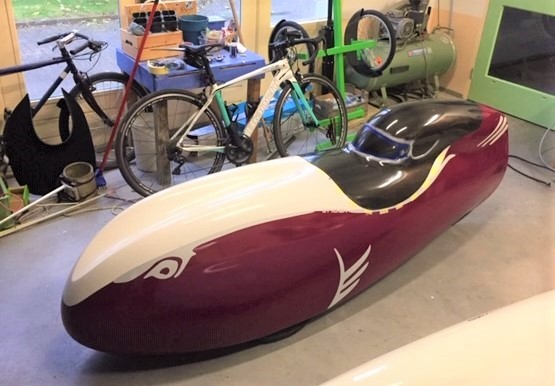
Given our conversation in another thread, it’s interesting to compare the capabilities of an Alleweder with electric cars. Someone once took the pedals out of a similar but fully enclosed velomobile and replaced them with an electric motor. The result was a vehicle that they argued was 80x more efficient than an electric car (Nissan Leaf) and could cruise around at speeds of 50kph. Even if the figure is off by quite a margin (for one thing, the car might be carrying 5 people – though it probably won’t be), you could argue that velomobiles are a much better solution than electric cars for individuals travelling short to medium distances. The problem with cars isn’t that they’re powered by fossil fuels, but that they’re far bigger than they generally need to be, and the world has been designed around them. Electric cars don’t change these fundamental problems. I don’t expect to see velomobiles, electrified or otherwise, taking over the world any time soon, not because they’re impractical for many trips but because people in most countries will see them as being less safe than cars. In the short term this is undoubtedly true. I think my Alleweder is probably safer than a bicycle, but I am under no illusions that it would fare well in a contest with a Range Rover. In the longer term, the health benefits of regular cycling far outweigh the risks. After 8 years of fatherhood during which I haven’t touched a bike, I can feel my fitness finally starting to come back as the hills start to seem less steep. Perhaps in a decade, when electric cars can drive themselves, we will be able to have the best of both worlds.
* for physiological reasons, power output is probably reduced in the recumbent position.
kwlf wrote:
The result was a vehicle that
…is the Sinclair C5. He was just a bit ahead of his time, that’s all :-) (A velomobile with a modern lithium battery and brushless motors really is basically what the C5 concept ought to have been, had the technology existed at the time).
kwlf wrote:
The problem with cars isn’t that they’re powered by fossil fuels, but that they’re far bigger than they generally need to be
Yes – and drivers generally don’t see the irony when they whine about cyclists riding two abreast, yet they are the only occupant in a vehicle that’s as wide as four cyclists abreast! There is a Tesla local to me that is (and I looked it up) only 9cm narrower than a full size Transit van, which is kind of ridiculous.
You’re right.
The C5 has a poor reputation within the human powered vehicle fraterrnity, because whilst they applaud what it was trying to do, there was a feeling that had Sinclair talked to people a bit more, the vehicle could have been made a lot more practical even back in the day. The geometry was such that it ended up as a poor tricycle that was hard to adjust for different riders. Battery technology was such that it made a poor electric vehicle too, and I think there were legislative difficulties that limited it compared to modern electrified bicycles. Nobody ’s yet cracked the problem of manufacturing an affordable electrically assisted velomobile. Perhaps Sinclair came closer than most.
To be fair on the Tesla drivers, they’re likely to be going faster than the cyclists on the open road. Congestion and safety to pedestrians is another matter though. I have spent some time living in villages with no roads. They can be made much more compact if you don’t have to cater for cars which means that it’s easy to walk wherever you want to go, and kids don’t need constant ferrying to play dates or sports venues because they can walk or cycle wherever they want to go in relative safety. They are much quieter, with no road noise. There’s a lot to be said for it.
alioth wrote:
Yes – and drivers generally don’t see the irony when they whine about cyclists riding two abreast
I think you’re misunderstanding why they’re complaining. It’s not just that they’re riding two abreast it is that they are generally so much slower that they’re a big bottleneck to traffic.
Much as walkers would be to cyclists if they chose to walk side by side filling up the carriageway.
It is an interesting build you have, and sort of reminds me of the morgan three wheeler.
Off_Field wrote:
that they’re a big bottleneck to traffic
Only because the traffic is unnecessarily wide. Motorcyclists don’t get bottlenecked, and on many roads, older, narrower cars wouldn’t have much of a problem passing. The problem we have now is the modern Mini is wider than a 1990s Ford Sierra, and luxury cars are as wide as full size Transit vans. I was following the local Tesla on my way back from the airfield recently, and its driver couldn’t keep this behemoth on his side of the road – his offside tyres were on the centreline and he kept having to slow and pull in for oncoming traffic!
kwlf wrote:
In the longer term, the health benefits of regular cycling far outweigh the risks. After 8 years of fatherhood during which I haven’t touched a bike, I can feel my fitness finally starting to come back as the hills start to seem less steep.
My father is now in his early nineties would agree with you. In his 50s, over quite a number of years, he put something like 25,000 miles on a recumbent bike riding to work. He claims that is a major factor in his longevity, and common sense would say he is right. He eventually had a significant accident at around age 60, mainly his own fault because he didn’t keep the steering head bearings adjusted properly and it wobbled going fast down a hill and spit him off. Lots of abrasions. Risk and reward like everything else, but overall cycling worked for him.
The issue with cars versus bicycles ridden two abreast or weaving is that bicycles are very slow, particularly going up hill. If corners are blind its an accident waiting to happen, because there is no way a car can or will drive slow enough to allow sufficient time to set up for the pass. Even when passing bicycles on a motorcycle this is an issue, I’ve done a lot of that and there’s only a split second to see and steer around.
I have heard motorcyclists grumbling about cyclists side by side on b roads, especially when enjoying a “spirited ride” running up the back of a couple of lycra snails is not much fun for them.
Cars are not the only road users, vans, wagons, etc all use the road as much greater speeds than your average cyclist.
I’ve an old porsche which is narrower than a mk1 mx5 and cyclists that are inline in to the side are generally not much of a problem. Side by side down the middle of a road, yes they are a severe hindrance to otherwise enjoyable progress.
I’m not grumbling, just explaining my experience  Roads are for everybody, and so are the choices and risks in using and enjoying them.
Roads are for everybody, and so are the choices and risks in using and enjoying them.
Cyclists in the Alps amaze me in a positive way, they are amazingly fit
Silvaire wrote:
Roads are for everybody
As much as I like this idea, it isn’t really true. You can’t take a tractor, scooter, push bike on a motorway.
I think the issue is with big speed differential, slow users that choose to be more of a roadblock (side by side vs tandem) are not very helpful.
Cycling two abreast versus in-line is a judgement call. The counterargument is that it can be harder to pass two in-line cyclists safely if they are well spaced out than it is to pass two cyclists side-by-side. Secondly, a lot of drivers will pass cyclists closer than they should so if there is enough room to pass a cyclist but not enough room to pass a cyclist safely, the cyclist should move further out into the road to block it. This is official UK advice (‘Cyclecraft’, published by her majesty’s stationery office).
Nobody wants to cycle on motorways so that’s a bit of a straw man. That said, many dual carriageways are designated cycle routes and there are some towns within the UK that it is not possible to access without cycling on very busy roads..
I remember you talking about your father’s accident Silvaire, but hadn’t realised it was on a recumbent. They seem to appeal to aerospace types.